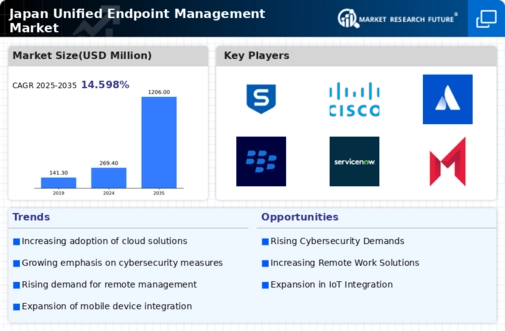Growing Adoption of IoT Devices
The proliferation of Internet of Things (IoT) devices in Japan is significantly impacting the unified endpoint-management market. As more organizations adopt IoT technologies, the complexity of managing these devices increases. Unified endpoint management solutions are essential for ensuring that IoT devices are securely integrated into corporate networks. This trend is likely to drive the demand for comprehensive management systems that can handle a diverse array of endpoints, including smart devices and sensors. Recent estimates suggest that the number of IoT devices in Japan could reach 1 billion by 2026, highlighting the urgent need for effective endpoint management solutions. Consequently, the unified endpoint-management market is poised for growth as businesses seek to implement strategies that accommodate the expanding IoT landscape.
Increased Cybersecurity Threats
Japan has witnessed a surge in cybersecurity threats, prompting organizations to invest heavily in endpoint management solutions. The unified endpoint-management market is responding to this challenge by offering advanced security features that protect against malware, ransomware, and data breaches. With cyberattacks becoming more sophisticated, businesses are compelled to adopt comprehensive endpoint management strategies that encompass threat detection and response capabilities. Recent statistics indicate that 60% of Japanese companies have reported an increase in cyber incidents, underscoring the urgent need for effective endpoint management. This growing concern for cybersecurity is likely to drive the adoption of unified endpoint-management solutions, as organizations seek to safeguard their digital assets and maintain compliance with regulatory standards.
Regulatory Compliance Requirements
The regulatory landscape in Japan is becoming increasingly stringent, particularly concerning data protection and privacy. Organizations are required to comply with various regulations, such as the Act on the Protection of Personal Information (APPI). This compliance necessity is influencing the unified endpoint-management market, as businesses seek solutions that facilitate adherence to these regulations. Effective endpoint management systems can help organizations monitor and control data access, ensuring that sensitive information is handled appropriately. As a result, the demand for unified endpoint-management solutions is expected to rise, with companies investing in technologies that streamline compliance processes. The market is projected to expand as organizations recognize the importance of maintaining regulatory compliance while managing their endpoints efficiently.
Rising Demand for Remote Work Solutions
The increasing trend of remote work in Japan has led to a heightened demand for effective management of endpoints. As organizations adapt to flexible work arrangements, the unified endpoint-management market experiences significant growth. Companies are seeking solutions that enable secure access to corporate resources from various devices, ensuring productivity and data protection. According to recent data, the market is projected to grow at a CAGR of 15% over the next five years, driven by the need for comprehensive endpoint management solutions. This shift necessitates robust tools that can manage diverse devices, including laptops, smartphones, and tablets, all while maintaining security protocols. The unified endpoint-management market is thus positioned to benefit from this evolving work culture, as businesses prioritize solutions that facilitate remote operations without compromising security.
Technological Advancements in Endpoint Management
Technological advancements are playing a crucial role in shaping the unified endpoint-management market in Japan. Innovations such as artificial intelligence, machine learning, and automation are enhancing the capabilities of endpoint management solutions. These technologies enable organizations to automate routine tasks, improve threat detection, and optimize resource allocation. As businesses increasingly rely on technology to manage their endpoints, the demand for sophisticated solutions is likely to grow. The market is expected to witness a surge in investment as companies seek to leverage these advancements to enhance operational efficiency and security. Furthermore, the integration of advanced analytics into endpoint management systems is anticipated to provide organizations with valuable insights, driving informed decision-making and strategic planning.























Leave a Comment